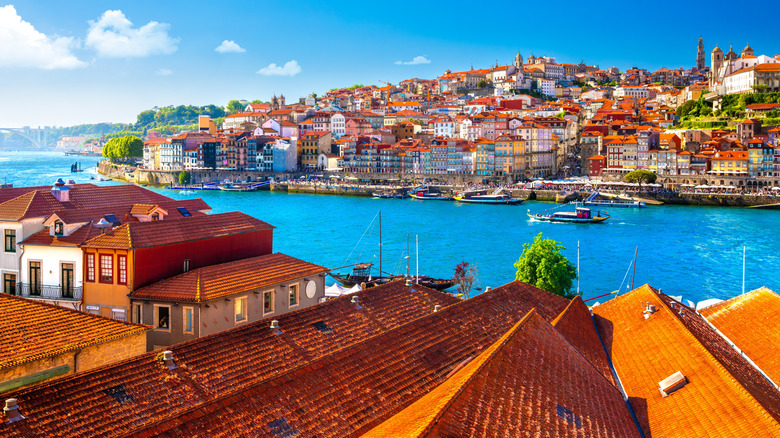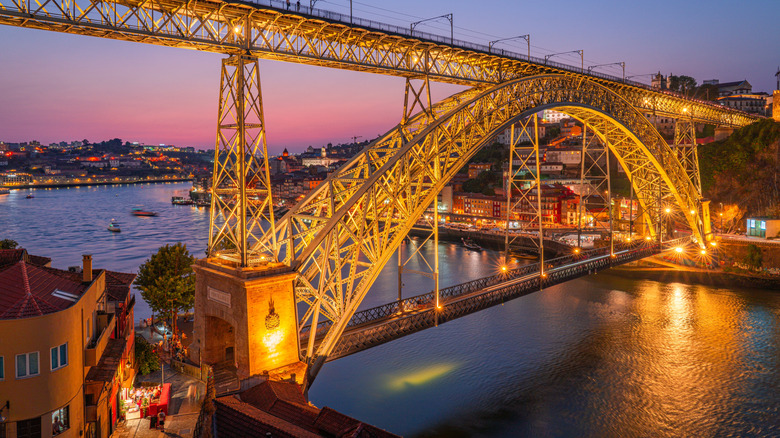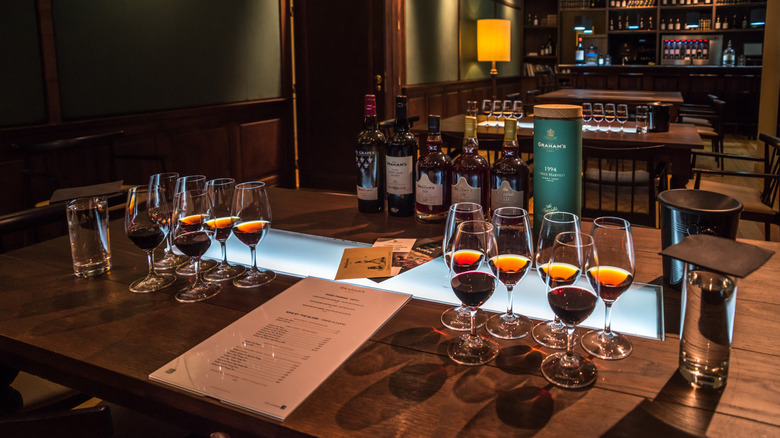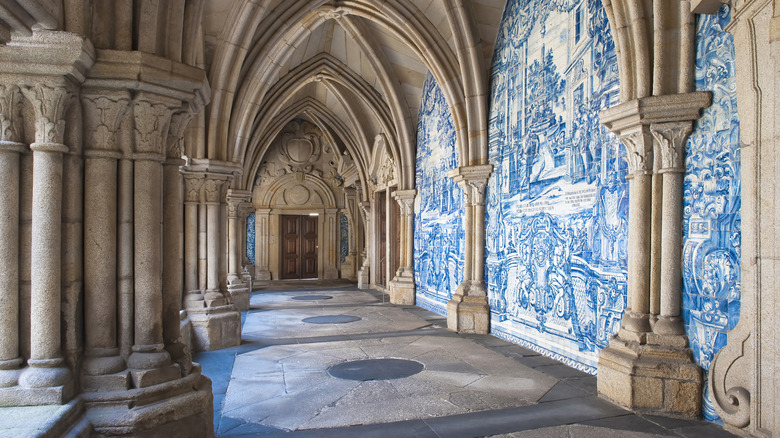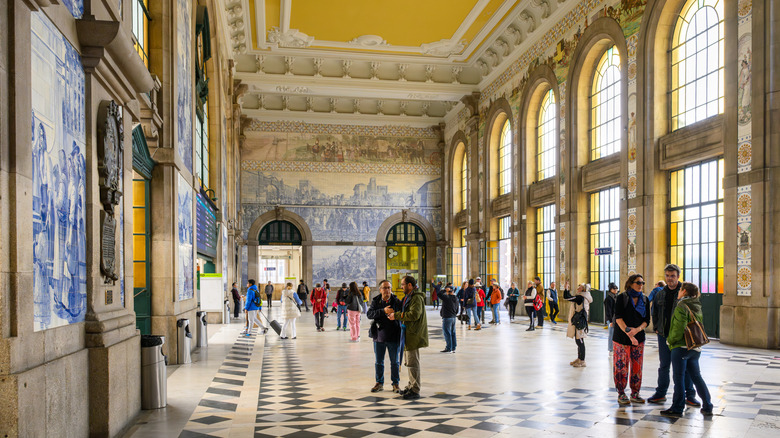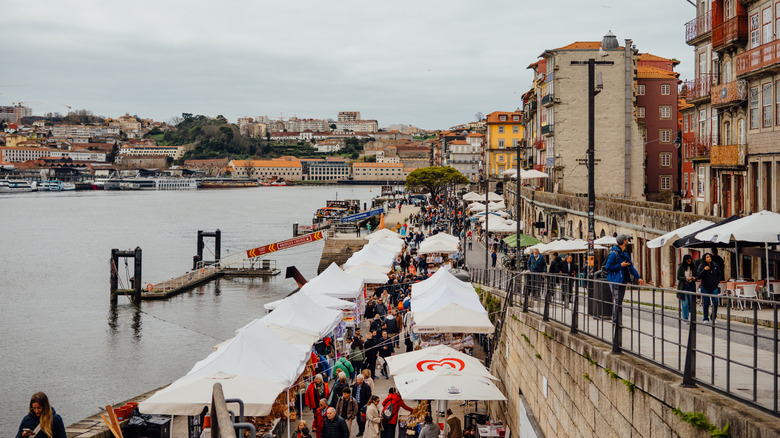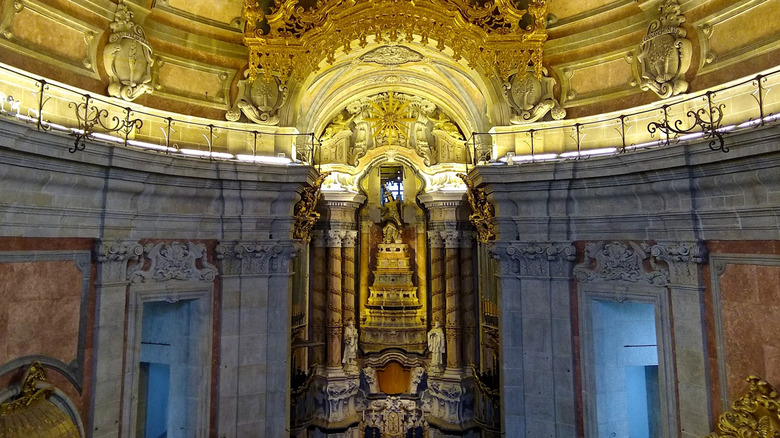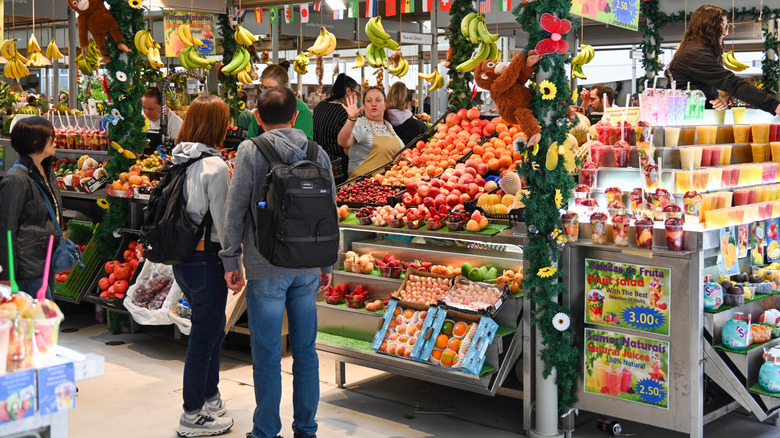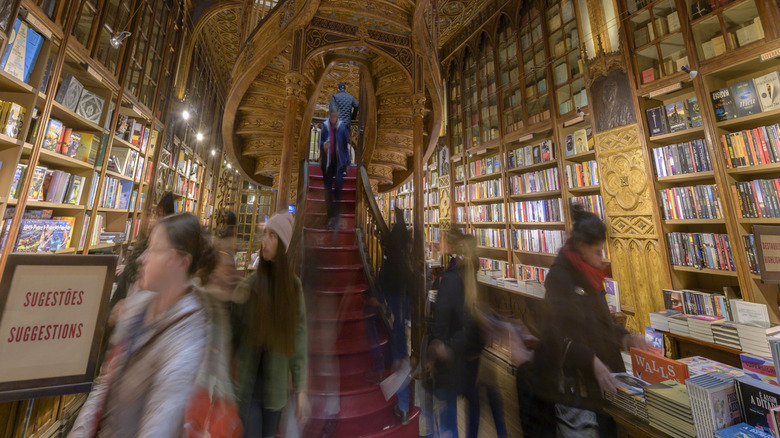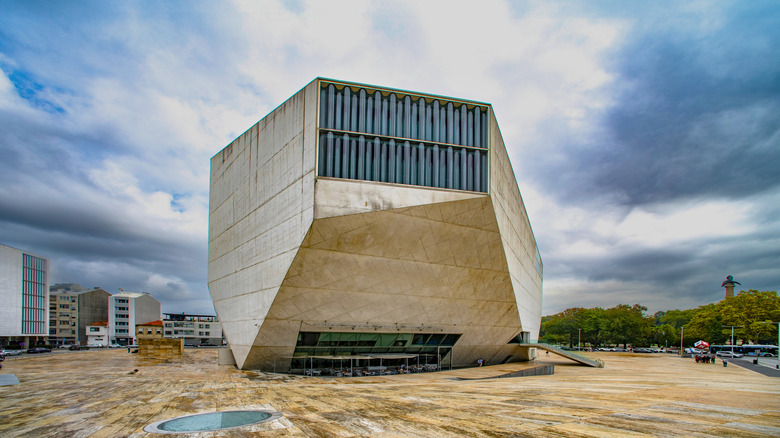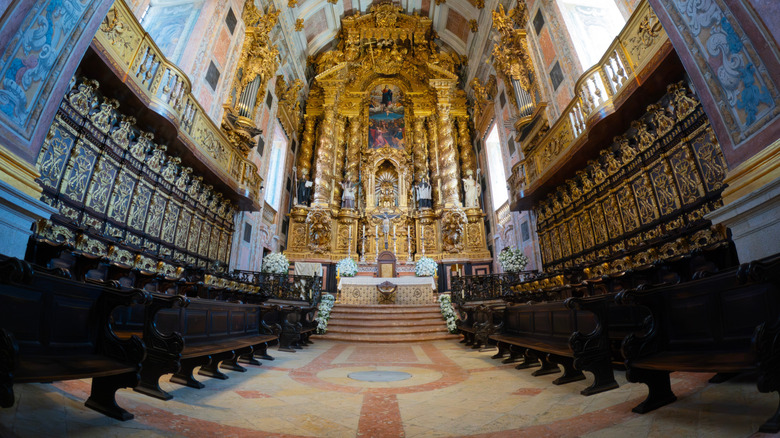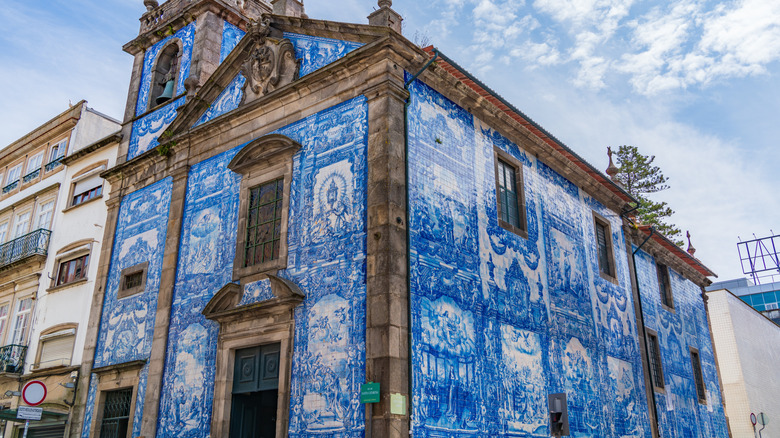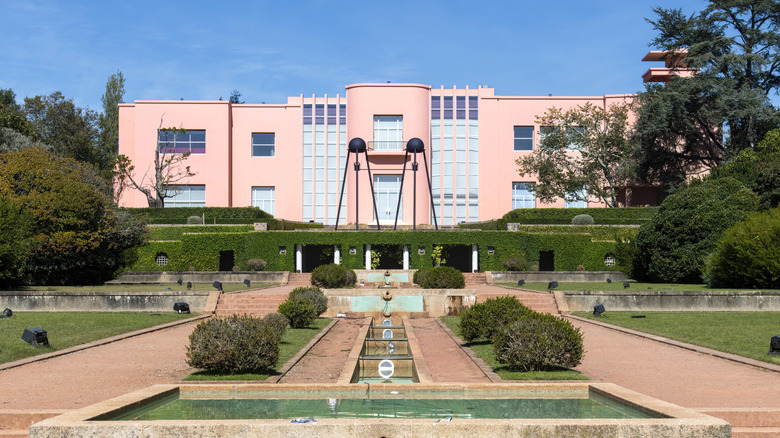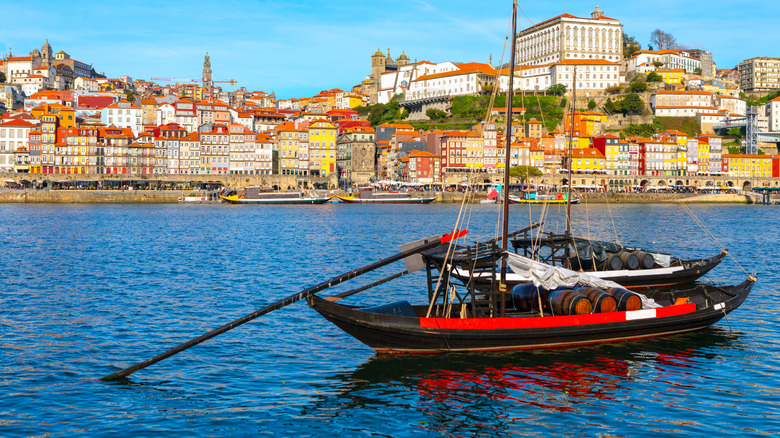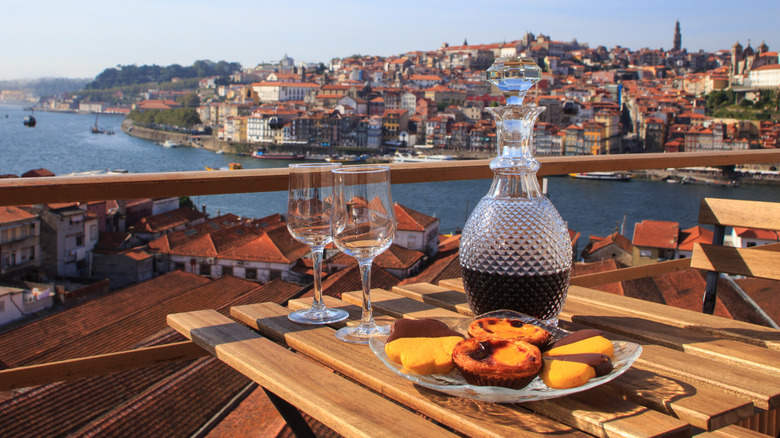Porto, Portugal's 13 Most Iconic Tourist Attractions To Visit On Your First Trip
While Porto is Portugal's second most populous city, it has a distinctively laid back atmosphere that makes it a relaxing destination to visit. Located in the north of Portugal just inland from the Atlantic Ocean, Porto sits along the breathtaking Douro River that flows from the Serra do Marão, surrounded by the luscious vineyards that produce the grapes used in the world-renowned port wine. Overall, it's a place where history, culture, and gastronomy converge along steeply inclined streets, colorful riverside neighborhoods, and centuries-old architecture.
Porto's historic core is rich with iconic landmarks that helped earn it UNESCO World Heritage status — from Romanesque cathedrals to Baroque churches, centuries-old markets, and bustling squares. Each site tells a story about the city's evolution over the centuries. Alongside these architectural wonders, Porto's cultural creativity is showcased in its many museums, galleries, and music venues. It's recognized as a European Capital of Culture, celebrating creativity and artistic expression at every turn.
Whether you're still deciding between traveling to Lisbon or Porto or actively looking for tips to help you enjoy your upcoming vacation, this guide for first-time visitors highlights the city's most compelling sites, focusing on the experiences that define its character and charm.
Dom Luís I Bridge
Feel the pulse of the city of Porto while walking across this 19th-century masterpiece of modern urban engineering. Built by a student of Gustave Eiffel — the man who designed the Eiffel Tower — the Dom Luís I Bridge is a defining feature of Porto's identity, and an enduring part of its history. The first bridge that connected the two sides of the Douro River is said to have been made of nothing more than a long line of boats chained together and was called the Ponte das Barcas, or "Bridge of Boats." A few centuries later, another iteration of the bridge collapsed under the weight of civilians fleeing Napoleon's Second French Invasion.
Today, the bridge's double-decker iron construction stands on solid ground. The latticework is reminiscent of the Eiffel Tower's pillars, and echoes a romantic quality about it. Visitors can choose to walk or cycle across the top of the bridge, which is made for pedestrians and the tram only. You can also walk across the lower level's sidewalks, where there is also car traffic, for a view closer to the river. Finally, there is also a funicular that takes visitors from the upper deck to the lower deck, and vice versa, for a small fee. The bridge connects Porto's Ribeira district with the smaller town of Vila Nova de Gaia, the hub of the port wine industry and a must-visit for wine tasting in Porto.
Port wine lodges
Recognition for Porto's wine production took off in the 17th century in the Douro River valley region, one of the oldest wine regions in Europe. In particular, it's known for producing port — a wine fortified by adding a neutral grape-based spirit called aguardente ("fiery water"). The wine was historically transported by boat from the valley to the cellars located in Gaia to age, before being shipped out to far away destinations.
Today, many wine lodges are in use just across the river in Vila Nova de Gaia, often referred to simply as Gaia, where there are dozens to choose from. And although most are owned by English companies, there are still a few Portuguese-owned lodges as well. Each lodge offers a unique experience, but most include a combination of education on the historical context of port production, touring the underground cellars, and tasting a curated selection of ports and sometimes wine.
If a lodge tour leaves you thirsty for more learning about the region and industry, it's worth making a stop at the relatively new World of Wine Museum, also in Gaia. The complex, which opened in 2020, is made of seven museums dedicated to celebrating the history and culture of wine, port, and drinking. Their collection of artifacts in The Art of Drinking museum — including chalices and cups that are thousands of years old — is especially fascinating.
Sé Catedral do Porto (Porto Cathedral)
There are a lot of hills in this city, and getting to the Porto Cathedral is quite a trek — but the views are worth it. Perched atop Porto's historic Sé district, the Porto Cathedral is one of the city's most important and recognizable landmarks. Its elevated location offers sweeping panoramas of the Douro River and the terracotta rooftops of Ribeira, making it an essential stop for anyone exploring Porto's medieval heart for the first time. As one visitor wrote on Tripadvisor: "Listed as a National Monument, Porto Cathedral is not only a religious building: it is a journey through the history, art and soul of the city."
At its core is a striking Romanesque structure dating back to the 12th century. Its fortress-like facade and rose window remain iconic examples of the style. Over the centuries, Baroque renovations added ornate chapels, decorative stonework, and a grand cloister. The cathedral is dedicated to Porto's patron, Our Lady of Vandoma, whose image appears throughout the building.
The Porto Cathedral is also known for the historical events it has witnessed. Several royal weddings took place within its walls, reflecting its prominence in Portugal's political history. Music enthusiasts will also appreciate its famous organs from the 17th and 19th centuries — magnificent, complex instruments whose haunting sound still fills the cathedral during special performances. Regular worship services are offered daily.
Estação de São Bento (São Bento Railway Station)
Located in the heart of Porto, São Bento Railway Station is both a transit hub and an ode to the city's enchanting creativity. Today, São Bento remains a lively and essential part of Porto's daily rhythms, and the station has an undeniably magical atmosphere. It's a convenient starting point for day trips to nearby towns, the Douro Valley wine country, and coastal destinations, especially if you're traveling to Portugal on a shoestring budget that requires sticking to public transportation.
What makes São Bento truly unforgettable is its vast entrance hall, a masterpiece of early 20th-century design. Black-and-white marble tiles add to the echo of travelers' footsteps. Graceful arches and opulent crown molding frame the space, drawing the eye upward before it settles on the station's real showstopper: a wall of approximately 20,000 hand-painted Azulejo tiles, illustrating everything from grand historical battles to rural traditions. These famous blue-and-white ceramic tiles that draw on Islamic and Italian traditions cloak the room in centuries of Portuguese history. Stained glass windows add a soft luminescence to the grand scene of new and old weaving together.
Cais de Ribeira (Ribeira Quay)
Set along the banks of the Douro River in one of Porto's oldest neighborhoods, the Ribeira Quay embodies the city's charm at its most picturesque. With its jumble of colorful facades, narrow lanes, and lively waterfront energy, it's no wonder this spot graces so many of Porto's postcards. The quay captures the city's distinctively relaxed spirit, offering a warm welcome to first-time visitors.
A stroll along Ribeira Quay is one of the most enjoyable ways to experience Porto. Along the inviting promenade, day and night, you're bound to pass by live music, one of Porto's six bridges, and the historic tram that goes to the chic seaside village of Foz. Many of the colorful historic storefronts have been converted into modern boutiques, cafes, and small taverns. This is an ideal place to sit back and savor classic Portuguese flavors. Visitors can settle into a cafe terrace to enjoy a warm pastéis de nata, paired with a glass of port wine, surrounded by the gentle hum of life along the river — the perfect way to spend a lazy afternoon in Porto.
Torre dos Clérigos (Clerigos Tower)
Rising prominently over Porto's skyline, the Clérigos Tower is known as one of the city's tallest landmarks. Built in the 18th century, the tower reflects the city's deep historical ties to the church. Its elegant Baroque architecture, designed by the Italian architect Nicolau Nasoni, has made it a symbol of Porto's artistic and religious heritage.
For those willing to make the ascent, climbing the 225 narrow steps to the top of the 246-foot tower is highly rewarding. The viewing platform offers a spectacular 360-degree vista stretching out towards the wine cellars of Vila Nova de Gaia on the other side of the Douro River. It is considered by many visitors as the best viewpoint in Porto.
The Clérigos Museum, located within the larger complex, also provides valuable context. Exhibits delve into the tower's construction, the life and works of Nasoni, and the religious history that shaped both the church and the city around it.
Mercado do Bolhão (Bolhão Market)
Foodies in search of the best place to sample traditional Portuguese cuisine, look no further than the historic Bolhão Market. One of Rick Steves' favorite markets in Europe, the roughly 80 food stalls are located in Porto's downtown district and housed in a truly unforgettable Beaux-Arts building that occupies an entire block. The market, along with the shops and restaurants located in the upper levels, has made an indelible mark in the day-to-day life of the city for nearly two centuries. Today, it remains a popular meeting ground for tasty exchanges and aromatic discovery.
The colorful stalls are stocked with local artisanal products, often from family-run businesses. Walk amongst lines of fresh produce, meat, fish, and wine to create your own platter full of assorted classic dishes — including bolinhos de bacalhau (cod fish croquettes), sardines, salada de polvo (octopus salad), enchidos (cured meats), and local goat cheeses. Of course, top it off with a glass of port and a sweet treat: the pastel de nata, Portugal's national dessert, is made with a firm flaky crust and decadent custard filling.
Livraria Lello (Lello Bookstore)
Lello Bookstore is one of Porto's most visited locations — and, arguably, one of the most beautiful bookstores in the world. A masterpiece of neo-Gothic architecture, the building is adorned with art deco accents, stunning stained-glass windows, and masterfully carved interiors from floor to ceiling.
At the heart of the architectural masterpiece is the famous staircase. A set of stairs has never made a grander entrance: The reinforced concrete steps are painted crimson-red and flanked by dark wood banisters, and its bewildering spiral design — without any obvious supporting beams — gives you the impression that the stairs are floating over the endless rows of books below.
Most of the books sold at Lello celebrate Portuguese-language titles, though there is a small selection of classic English-language literature. Of special interest for real literary nerds is Gemma, a special area in the bookstore dedicated to rare books and first editions. However, since the vast majority of foreign visitors aren't there to purchase books, there is a ticket price of about $12 to enter the store.
Casa da Música (House of Music)
The architecture and decoration of Porto's Casa da Música is in itself remarkable. This cultural complex is where Porto's modern ambitions collide with its historic Old World charm. The building's architect, Rem Koolhaas, once said in an interview: "The ideal acoustic form for a concert hall is a shoe box. And we have seen a lot of architects trying to make shoe boxes interesting, or to design interesting shoe boxes. We got rid of the shoe box." Indeed, the massive white polyhedron has been said to resemble everything from a concrete mushroom to a spaceship.
Inside, dazzling interior spaces that play with sharp angles and patterns of light are no less impressive. They immerse visitors in a sensorial experience that's at the heart of what draws some of Europe's most talented artists to the city. Visitors can tour the house's many spaces, whose fluidity and openness have a way of making its more intimate rooms feel as if they flow naturally with the grandness of its contours.
The Casa da Música is home to a dynamic yearly lineup of performances, including from its five in-house music ensembles. While the programming enjoys a healthy dose of traditional classical music, it also showcases Portugal's musical diversity, including traditional Fado and expanding through pop, rock, electronic, and beyond.
Igreja de São Francisco (Church of San Francisco)
The Church of San Francisco is one of the city's most extraordinary religious monuments. Originally built in 1245 by the Franciscan Order, the church still preserves its soaring Gothic arches and stone tracery. However, it's the later Rococo additions that leave visitors truly stunned.
The church's interiors feature glittering gold leaf, elaborate wood carvings, and intricate altarpieces, and the richly decorated nave is considered a masterpiece of Portuguese Baroque craftsmanship. Nearly every surface is covered in ornate gilded woodwork. The church's dramatic combination of Gothic and Rococo artistry is why it has a reputation for having one of the most lavish church interiors in all of Portugal.
Below the church lies an entirely different experience: the catacombs. Here, visitors can explore the burial chambers that once held Franciscan monks and members of some of Porto's wealthiest and most influential families. Rows of tombs and memorial plaques, as well as piles of thousands of human bones, create a haunting experience.
Capela das Almas (Chapel of Souls)
The Chapel of Souls is situated in Porto's bustling shopping district along Rua de Santa Catarina. Its exterior immediately captures attention, standing out amid modern storefronts with a facade that glows in shades of blue and white. This small chapel has become a must-see sight, not only for its religious significance but also for its extraordinary artistry.
Introduced to the Iberian Peninsula in the 15th century, Azulejo tiling has since been refined over generations into one of the country's most distinctive visual features — and the Chapel of Souls is a true masterpiece of Azulejo tiling. Covering its exterior walls are nearly 15,000 hand-painted ceramic tiles, each meticulously placed to form sweeping narrative scenes that depict the lives of Saint Francis of Assisi and St. Catherine. The panels were painted by artist Eduardo Leite and produced by the renowned Fábrica de Cerâmica Viúva Lamego — one of Portugal's most historic tile manufacturers.
Although the chapel itself dates back to the 18th century, the famous exterior tiles were added in the early 20th century. The sheer scale of the artwork makes the building truly stand out for first-time visitors as a picture-worthy destination.
Fundação de Serralves (Serralves Foundation Complex)
Serralves is a sprawling cultural complex tucked away from downtown Porto in a quiet neighborhood, where nature and culture meet Portuguese history. As one reviewer wrote on Tripadvisor: "This estate was well worth a visit, an oasis and one of my highlights away from the busy streets of Porto and Lisbon."
The complex includes the Serralves Contemporary Art Museum, which is in itself worth visiting as an architectural wonder. The space features a rotating collection of visiting exhibitions and a collection containing key references for contemporary Portuguese art. Next door, the Casa do Cinema Manoel de Oliveira, inaugurated in 2019, offers tastefully curated screenings and exhibitions on the most influential filmmakers in Portuguese cinema. And you can't miss the Villa, a bright pink building with interiors that highlight the eccentricities of 1930s Art Deco, including a pink marble bathroom and furnishings hand-crafted by masters of the era.
These buildings are all situated in the 45-acre Serralves Park, formerly the estate of a wealthy noble family. The park is home to formal gardens, woodlands, and a farm complete with cute pigs and donkeys. It's an ideal spot for contemplating after indulging in the arts, amid a collection of 200 species of native and exotic plants. Don't miss the park's popular treetop walkway —a short wooden path built amongst the park's gorgeous trees at about 50 feet above ground.
Douro River cruise
One of the most quintessential (and simultaneously relaxing) ways to immerse yourself in the culture and history of Porto is to see it from the perspective of the river that runs through it and has defined its trajectory — the Douro River. The fortunes of Porto were built over centuries of development and trade within the fertile climate of the Douro River Valley, nestled by the Marão Mountains. Wine grapes have been grown in the region since ancient times, transported from the inland vineyards upriver to the cellars and docked ships of the city.
Many boat tours available from Porto are designed to help visitors understand the region's natural beauty and historical commercial significance. These tours range from short 45-minute rides skirting the perimeter of the city to full-day outings further into the valley. There's also a wide range of cruising styles to choose from — including riding into the past in a rabelo boat traditionally used to haul barrels of wine or soaring along the water's surface in a modern, luxurious sailboat. Naturally, most tours include a glass of wine, and many also include food.
Methodology
This article offers first-time visitors a diverse selection of attractions in Porto that are among the most iconic sites in the city. The research process for this article began with a survey of what other well-established travel publications consider the top attractions in Porto. These lists provided a broad overview of the most significant landmarks that define the city's unique touristic personality. This initial survey made it possible to establish a longlist of the most iconic destinations that would likely be of interest to first-time travelers.
From there, we examined detailed descriptions of each of the sites using travel blogs and regional tourism websites. From these sites, we gathered information about what makes each site noteworthy and relevant for first-time visitors, and were able to narrow down the list. Further details were gleaned from online review platforms such as Google Reviews and Tripadvisor, which provide first-hand, honest accounts of what the experience actually entails. Altogether, these sources helped create a solid list of the most beautiful and important landmark destinations in Porto.
